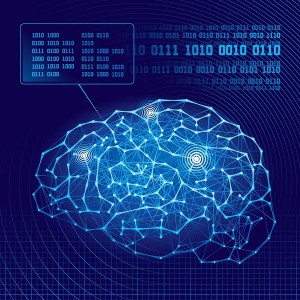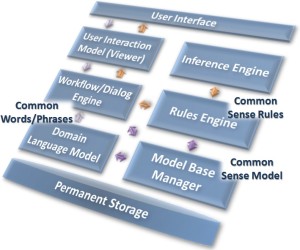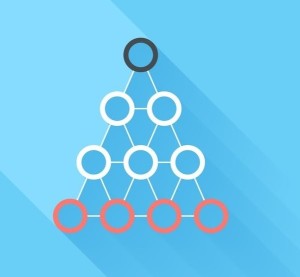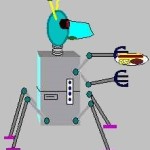29 Dec Unhuman Expertise
 Artificial Intelligence has suffered from a persistent scale problem: up to now, many techniques have been shown to work well and reliably in narrowly defined domains, but outside the domains of their expertise, they fall apart very quickly. No techniques of which I am aware, have exhibited common sense in the way we expect humans to possess, and exercise it.
Artificial Intelligence has suffered from a persistent scale problem: up to now, many techniques have been shown to work well and reliably in narrowly defined domains, but outside the domains of their expertise, they fall apart very quickly. No techniques of which I am aware, have exhibited common sense in the way we expect humans to possess, and exercise it.
Common Sense and Knowledge Systems
Because humans can retain a large quantity of context in their brains while understanding the world and analyzing statistics, we may not need to store in our brains the graphical representations that explicitly express different types of information. In other words, we can look at a scene, or a graphical report, quickly grasp the underlying content, and never need to explicitly think about the image again. Machines, on the other hand, need to be told everything explicitly. In order to generate useful analyses of scenes, or statistical data, the same context a human uses should be available to the computer. If this context is either unavailable or incomprehensible to a computer, the analysis will suffer.
| Understanding Context Cross-Reference |
|---|
| Click on these Links to other posts and glossary/bibliography references |
|
|
| Prior Post | Next Post |
| Visualization Deception | What’s in a Decision |
| Definitions | References |
| Artificial Intelligence domain | Cambria 2009 |
| information representation | Singh 2004 |
| context expert system | Sowa 1984 |
 This brings up the major justification for the discussions on measuring and visualizing knowledge, and quantifying knowledge central to broad reasoning processes from domain-specific knowledge that usually applies only in narrow contexts. Common sense knowledge constitutes a large portion of the context a person uses to interpret objects and events. This is the kind of knowledge that guarantees that it will be a long time before any robot can outperform Janey in gathering hidden Easter eggs. This is because traditional statistical techniques are generally inadequate for representing common sense knowledge, including techniques, strategies and rules for performing relatively mundane tasks. Representing common sense knowledge and using it to enable computers to analyze statistical data is the main thrust of this post and the next couple posts I’m preparing.
This brings up the major justification for the discussions on measuring and visualizing knowledge, and quantifying knowledge central to broad reasoning processes from domain-specific knowledge that usually applies only in narrow contexts. Common sense knowledge constitutes a large portion of the context a person uses to interpret objects and events. This is the kind of knowledge that guarantees that it will be a long time before any robot can outperform Janey in gathering hidden Easter eggs. This is because traditional statistical techniques are generally inadequate for representing common sense knowledge, including techniques, strategies and rules for performing relatively mundane tasks. Representing common sense knowledge and using it to enable computers to analyze statistical data is the main thrust of this post and the next couple posts I’m preparing.
Besides using common sense to do mundane things, experts use common sense to do really complex things. The common sense part of expert analysis, however, is sometimes omitted from expert system design. If the knowledge engineer can capture the common sense tasks that the expert uses routinely in conjunction with the complex tasks necessary to accomplish the mission, encoding the common sense information in the expert system KR scheme, the resulting system will be better able to match the performance of the expert.
Human-like Dimensions
Expert systems can be improved by adding a human-like dimension of common sense. In order to do this, however, it seems appropriate to model the problem with procedures that resemble human cognition in some way. A balance between appropriate knowledge representation and process structure can be used to model cognitive processes and imitate human behavior. In the next few posts, I plan to discuss knowledge representation and the inference mechanisms selected to achieve this goal.
 In a domain where human behaviors and traits are the subject, a great amount of ambiguity can be safely predicted. This ambiguity stems from the diversity of humans in a widely variable world. The variables include, among other things, ethnic, socioeconomic, geographic, demographic, educational, biological and historical factors. For example, if the focus of an analysis were a test administered to a population of third-grade students in a city in the United States, anomalies such as extremely high or low scores could be influenced by a number of these variables. Normally, this type of analysis would be delegated to a third-grade teacher who, through years of observation, would have developed a sense of how these factors interact. The teacher is considered an expert in this area, but much of his or her expertise can be described as common-sense knowledge.
In a domain where human behaviors and traits are the subject, a great amount of ambiguity can be safely predicted. This ambiguity stems from the diversity of humans in a widely variable world. The variables include, among other things, ethnic, socioeconomic, geographic, demographic, educational, biological and historical factors. For example, if the focus of an analysis were a test administered to a population of third-grade students in a city in the United States, anomalies such as extremely high or low scores could be influenced by a number of these variables. Normally, this type of analysis would be delegated to a third-grade teacher who, through years of observation, would have developed a sense of how these factors interact. The teacher is considered an expert in this area, but much of his or her expertise can be described as common-sense knowledge.
In corporate scenarios, statistical analyses usually focus on Key Performance indicators, or KPIs articulated as defined words or phrases. The ubiquitous ambiguity in humanity and all human activities makes statistical analyses, based on words that may have multiple meanings, inherently less reliable. Consequently, it is often necessary for human and automated analysts to weigh the results of analysis, and qualify them with fuzzy confidence values, flavored with a little common sense.
Common Sense and KR
Knowledge can be defined in terms of semantics or meaning. Semantic network formalisms are a popular way of expressing semantic relations between data objects. The illustration below shows three popular ways of building semantic nets. The first (A) is appropriate for directed acyclic graphs that need no labels for the links. Trees express a hierarchy in their structure independent of additional information. Labels, as shown in (B), can add expressiveness to the graph and increase the number of possible relations supported. The labels themselves can even be treated as objects.
Common sense is so complex that directed graphs may fail to capture the quantum interconnectedness of its knowledge. Instead, a conceptually structured network (Sowa, 1984) with intelligent links, or links that are more expressive of the precise nature of actual relations, would be more useful, as shown in C. This is akin to my approach to language understanding knowledge I introduced in my post on universal information theory, and I plan to elucidate it further in Section 9.
| (A) | Parent | Child | |
| (B) | Entity | Unnamed Relation | Associate |
| (C) | Entity | Named Relation | Associate |
 A, B or C above can be used to represent hierarchical associations. Hierarchical relations are familiar and should support inheritance rules or heuristics. Using unnamed relations, as in B, you can create any type of relation you need for a system, but you are limited to one type within that system. Ontological frameworks permit virtually unlimited types of relations that can define the association between objects. I believe, however, that proliferating relations loses its power when there are not rules or heuristics that apply generally to each relation type.
A, B or C above can be used to represent hierarchical associations. Hierarchical relations are familiar and should support inheritance rules or heuristics. Using unnamed relations, as in B, you can create any type of relation you need for a system, but you are limited to one type within that system. Ontological frameworks permit virtually unlimited types of relations that can define the association between objects. I believe, however, that proliferating relations loses its power when there are not rules or heuristics that apply generally to each relation type.
If we can develop an expert-system formalism that can capture common sense and expert knowledge in a conceptually structured model, we can use the formalism to develop superior systems that are better able to meet many of the more complex needs that are beyond the capabilities of current systems.
Common Sense in MT
The connection with our sample domain is straightforward: in order to figure out the meaning of a word with multiple possible meanings, we need to exercise some common sense. One typical common sense procedure is the process of elimination: “Well, it can’t mean that or that or that, so it must mean this.” We can often perform this cognitive process very quickly because of the context of the communication or text. When we are aware of the context, which is normally most of the time, we develop expectations and use those expectations to help us process the information quickly and accurately.
We discussed expectations in posts in Sections 5 (fuzzy Logic) and 6 (Language and Dialog), showing how they give us cues that help us interpret the continual stream of data that we encounter from second to second. The world is very cluttered with information, and much of the information is useless noise. So it is with data in computers. The more computers become able to store and process complex information, the better they need to become at filtering out the data that does not bear directly on the solution.
My posts planned for Section 9 will describe my object-centered approach that can help us achieve the lofty goals of highly accurate, fully automated language understanding and translation.
 MIPUS tries to understand the content and the intent of the things he hears. Earlier we explained that he interprets “We are finished eating” as “It is time to clear the table.” The content of the expression “finished eating” in the context of speaking to a utility robot is sufficient to infer the task. MIPUS has always had difficulty with prosody, the linguistic stratum of vocal intonation. Humans have a tendency to intone things in such a way as to mean the opposite of the content of the words. Sarcasm befuddles MIPUS.
MIPUS tries to understand the content and the intent of the things he hears. Earlier we explained that he interprets “We are finished eating” as “It is time to clear the table.” The content of the expression “finished eating” in the context of speaking to a utility robot is sufficient to infer the task. MIPUS has always had difficulty with prosody, the linguistic stratum of vocal intonation. Humans have a tendency to intone things in such a way as to mean the opposite of the content of the words. Sarcasm befuddles MIPUS.
Common sense knowledge may be the thing we humans rely on to infer “You’re kidding, aren’t you.” Until we can add a common sense module to MIPUS’ language heuristics and knowledge base, he will remain befuddled in the presence of irony, sarcasm, absurdity and metaphor.
| Click below to look in each Understanding Context section |
|---|








